The Saga of Colorado Gold: Part I
By Admin -
January 27, 2021
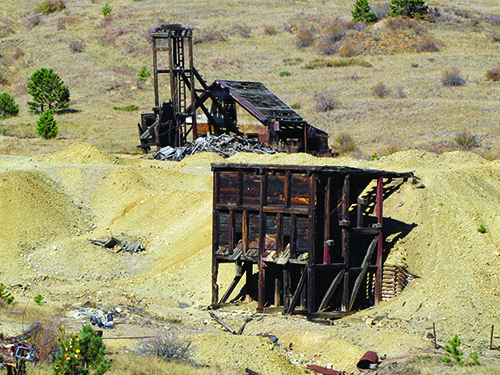
The ruins of old gold mines still dot the hills around Central City and Black Hawk, where prospectors made the first major discovery of gold in Colorado. (Steve Voynick)
By Steve Voynick
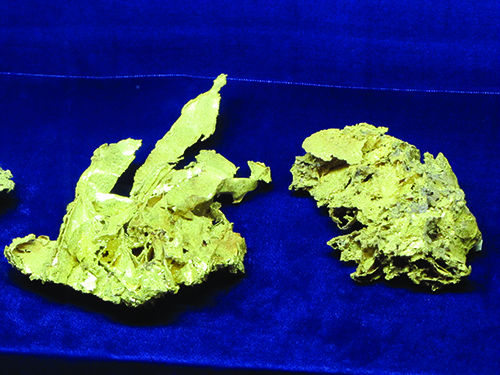
These samples of crystallized gold, including a six-inch specimen of Farncomb Hill crystallized gold at right, mined in the 1890s, is displayed at the Denver Museum of Nature & Science. (Steve Voynick)
Colorado has been mining gold even before the region became a territory and is still mining it today. In fact, some of Colorado’s newly mined gold was refined to .9999 purity and milled into 140,000 sheets of gold leaf just 1/8000th of a millimeter thick to regild the 250-foot-tall dome of the state capital building in Denver.
When Colorado’s capital was built in 1898, the dome was clad in copper. But in 1908, to mark the 50th anniversary of the Pikes Peak gold rush, the state fathers ordered the dome gilded with gold. Mine owners at the then-booming gold camp of Cripple Creek donated the required 200 troy ounces of gold. Cripple Creek miners also provided the gold for the recent regilding of the dome. However, this time, it took only 65 troy ounces, thanks to the ability to create an ever-thinner gold leaf. Another sign of changing times is the price of the gold itself: The 200 troy ounces needed to gild the dome in 1908 cost $4,000; today, the necessary 65 troy ounces cost $127,000.
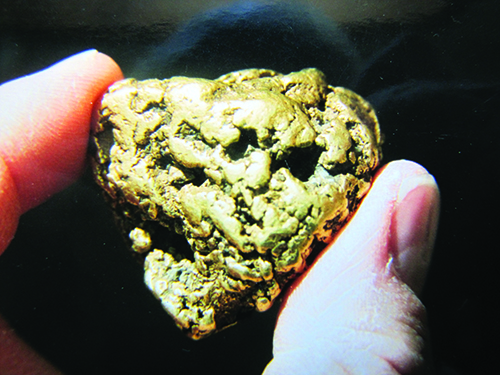
This 1.5-troy-ounce, flattened nugget was recovered by a floating, bucket-line dredge at Breckenridge in the 1930s. (Steve Voynick)
Speaking at the completion of the regilding project, former Colorado Governor John Hickenlooper called gold “a true Colorado treasure that symbolizes its past, present, and future.” Indeed, Colorado opened with a gold rush; today, it still produces 300,000 troy ounces of gold each year. As for its future, the former governor and now U.S. senator, a geologist himself, referred to the ability to economically extract gold from very low-grade ores that will enable Colorado to produce gold for decades to come.
Colorado’s historic gold production is now nearing 53 million troy ounces. That amounts to 1,648 metric tons, which would occupy a 14-foot cube and be worth $100 billion at today’s gold prices.
Humble Beginnings
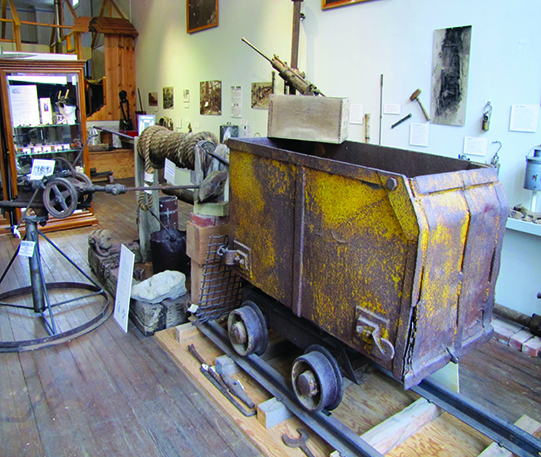
This display of mining equipment is typical of exhibits in Colorado’s many local gold-mining museums. (Steve Voynick)
A French trapper made the first reference to Colorado gold in 1758 when he wrote of a rivulet, possibly a tributary of the upper Arkansas River, “whose waters rolled down gold dust.” Over the next century, a dozen other reports told of gold in the same general region. Oddly enough, the first historically significant discovery, made in 1858 near the South Platte River in what is now southwest Denver, actually yielded very little gold. Nevertheless, a sack of gold-bearing gravel (doubtlessly concentrated) was brought to Westport (now Kansas City, Missouri) and panned before a wide-eyed audience.
Newspapers and promoters heralded the strike as the “next California” and, by spring of 1859, some 100,000 gold seekers had rushed to “Pikes Peak Country,” where they found not gold but only bitter disappointment. As many of these “fifty-niners” began heading back east, the Pikes Peak gold rush seemed destined to become one of the West’s bigger fiascos. But a handful of more determined prospectors headed the opposite way—west into the foothills of the Rocky Mountains, where they quickly made two major strikes that redeemed the rush at its darkest moment.
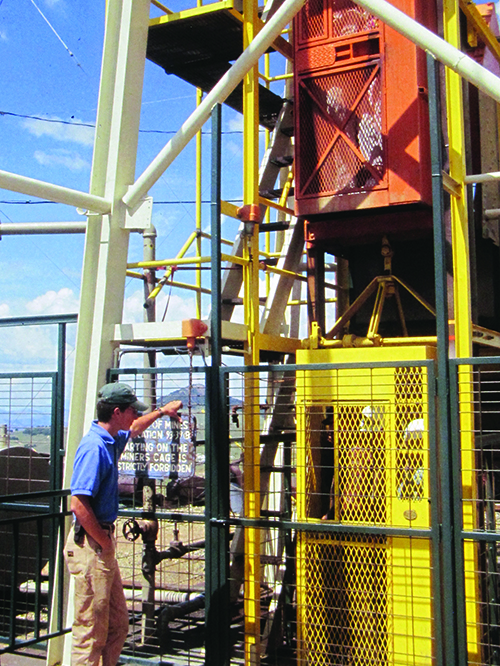
A cage filled with visitors prepares to descend 1,000 feet into the Molly Kathleen gold mine at Cripple Creek. (Steve Voynick)
The first strike was on the North Fork of Clear Creek near the present-day towns of Black Hawk and Central City; the second was on the South Fork at the future site of Idaho Springs. By summer, a dozen booming, placer-gold camps dotted the foothills just 25 miles west of Denver. Prospectors then panned their way west, making discoveries at Breckenridge, Alma, Tarryall, and Fairplay. By autumn, they had struck gold at California Gulch near today’s Leadville. In just five years, California Gulch, the richest strike of the entire Pikes Peak rush, yielded 300,000 troy ounces of gold worth nearly $5 million.
By 1870, when the rich discovery gravels had been largely depleted, the fifty-niners had panned and sluiced 1.3 million troy ounces of gold worth $25 million. In the process, they settled a wilderness, created a territory, and set the stage for far richer gold strikes. The search for gold has enriched Colorado’s history with wonderful tales of sudden wealth and, in some cases, of the heartbreaking loss of wealth.
Colorado’s Early Mining Legends
In 1878, Breckenridge miner Harry Farncomb found a rich, eluvial gold deposit in intricately twisted wires and delicate leaves. Farncomb quietly mined his find alone while buying the adjacent properties. Two years later, he revealed his discovery by depositing hundreds of troy ounces of beautiful, crystallized gold in a Denver bank, then sold his property, now known as Farncomb Hill, for a fortune.
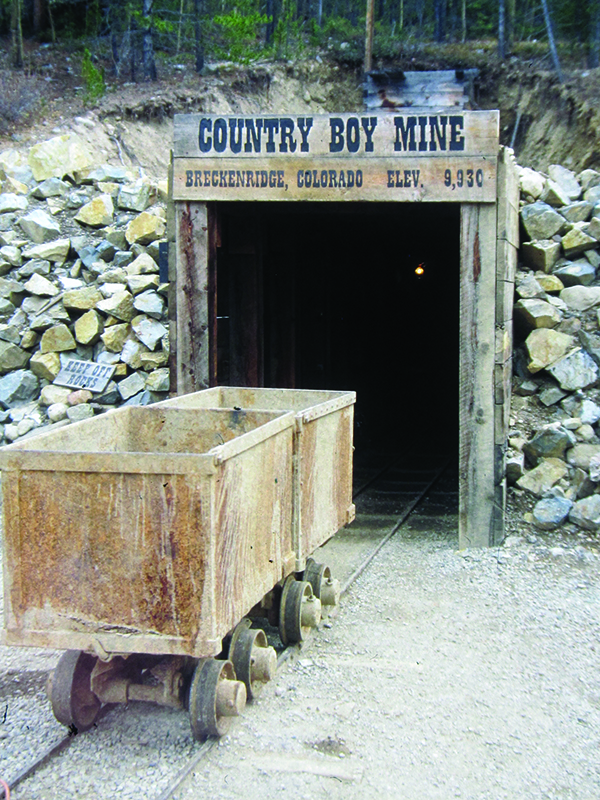
The Country Boy Mine at Breckenridge is one of Colorado’s 12 gold mines that offer public underground tours. (Steve Voynick)
In 1887, two miners leased a section of Farncomb Hill and recovered a 10-pound mass of crystallized gold. Named “Tom’s Baby,” it is still the largest single piece of gold ever found in Colorado. Farncomb Hill’s crystallized gold had a profound effect on the collecting and value of gold specimens. Because of its rarity and beautiful shapes, the specimen value of Farncomb Hill gold far exceeded its bullion value. In 1900, one of the founding gifts to the Denver Museum of Natural History (now the Denver Museum of Nature & Science) was a spectacular, 600-piece collection of gold from Farncomb Hill.
In southwestern Colorado’s San Juan Mountains, gold mining was delayed because of both Ute hostility and the lack of rich, easily mined placer deposits. Nevertheless, prospectors eventually found many lode deposits and, by the 1880s, camps like Telluride, Silverton, and Ouray had dozens of underground gold-silver-lead mines. The greatest rags-to-riches story in the San Juan Mountains was that of Thomas Walsh. Unlike most prospectors, Walsh did not search for new mineral deposits; instead, he assayed samples collected at abandoned mines. In 1896, he found gold-laced quartz in a mine dump near Ouray and traced it to an exposed vein that previous miners had somehow overlooked. That three-foot-wide vein contained 150 troy ounces of gold per ton.
Walsh bought the abandoned mine for a pittance. Then, backed by his phenomenal assay reports and uncontested ownership of the mine, he borrowed development capital. In just five years, his Camp Bird Mine, the richest American gold mine ever owned by a single individual, had yielded 200,000 troy ounces of gold and a clear profit of $2.4 million. Walsh then sold out for $6 million in cash, stock, and future royalties. His daughter Evalyn, the heiress to the Camp Bird fortune, later gained international notoriety as a socialite who purchased the Hope Diamond."[/i]
The Saga of Colorado Gold: Part II
By Admin -
January 29, 2021
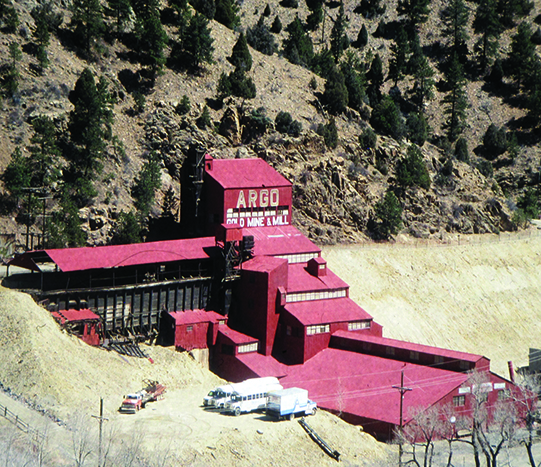
The Argo Gold Mine and Mill in Idaho Springs is a popular showcase of Colorado’s gold-mining history. (Steve Voynick)
By Steve Voynick
"By 1890, Colorado produced a quarter-million troy ounces of gold annually, a figure that would soon quadruple, thanks to an itinerant cowboy and part-time prospector named Bob Womack. In 1892, high on the western side of Pikes Peak at a lonely cow camp called Cripple Creek, Womack found gold-bearing rock that graded 12 troy ounces to the ton. But unlike Thomas Walsh, Womack did not go from rags to riches. Not knowing the actual extent of his discovery, he sold out for $300—only to learn later that he had found one of North America’s richest gold deposits. Production at Cripple Creek peaked in 1900 when 475 mines turned out 900,000 troy ounces—28 metric tons—worth $18 million. That year, Cripple Creek produced two-thirds of all the gold mined in the United States.
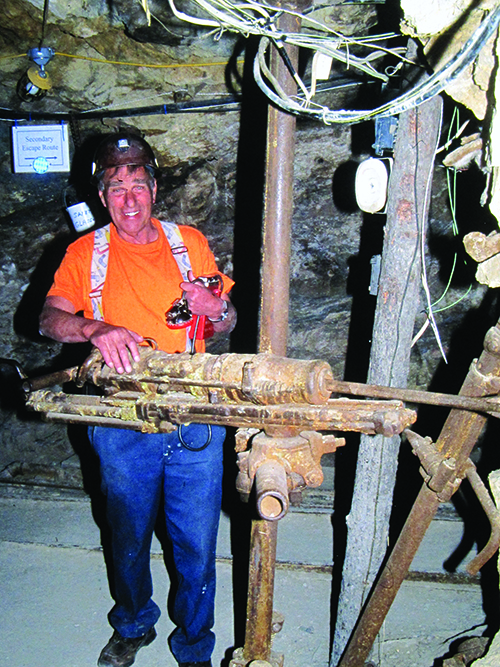
Al Mosch, owner and tour guide at the Phoenix Gold Mine in Idaho Springs, welcomes visitors to an underground tour. (Steve Voynick)
Cripple Creek gold occurred in elemental form and as the telluride minerals calaverite and sylvanite. Ores grading several hundred troy ounces of gold per ton were surprisingly common. Some ores were actually graded in dollars per pound, rather than the traditional troy ounces per ton.
In 1914, miners at Cripple Creek’s Cresson Mine blasted into a large vug 20 feet long, 15 feet wide, and 40 feet high that was lined with crystallized gold. Under the watchful eyes of armed guards, miners worked for a month to clean out what was named the “Cresson Vug.” Miners filled 1,400 sacks with gold flakes worth $400,000, then filled another 1,000 sacks with lower-grade material worth $100,000. Finally, they blasted and sacked the gold-laced rock in the vug wall. The Cresson Vug yielded 60,000 troy ounces of gold—nearly two metric tons—worth over one million dollars.
Because the native gold and gold tellurides in the Cripple Creek ores were often visible, many miners succumbed to the temptation to “high-grade” or steal the ore. Mine owners did everything possible to prevent high-grading, but the miners found creative ways to spirit gold out of the underground. Historians conservatively estimate that over 25 years, Cripple Creek miners high-graded one million troy ounces of gold worth nearly $20 million.
Growth By Way of Innovative Technology
By 1900, depletion of shallow placer gravels had made traditional sluicing only marginally profitable. Although much gold remained in the deep gravels, there was no economical way to mine it—until the introduction of the floating, bucket-line dredge. Steam-powered, floating dredges, developed in New Zealand in 1890, appeared in Breckenridge in 1898. Although notoriously inefficient, they were well-suited to work the deep gravels of the local rivers. When the dredges were converted from steam to electrical power in 1905, they became quite profitable.
The bucket-line dredges operated in several Colorado placer districts, but most extensively at Breckenridge. By 1916, the so-called “Breckenridge navy” consisted of six, 250-foot-long, bucket-line dredges and several smaller dredges. This dredge fleet operated until 1942, when it was put out of business by wartime restrictions on gold mining. The dredges had recovered 750,000 troy ounces of gold by then, making Breckenridge the all-time leading placer-mining district in Colorado.
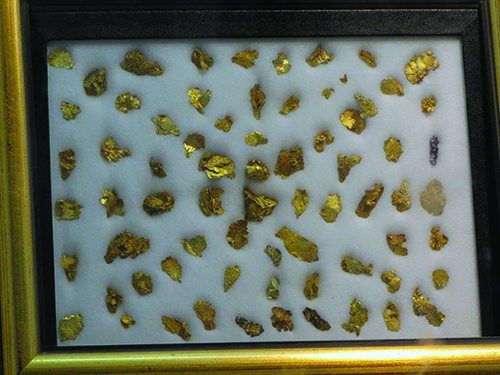
A framed, private collection of crystallized gold from Farncomb Hill at Breckenridge. (Steve Voynick)
Prospectors even found a few lode bonanzas after 1900. One was in the San Juan Mountains of Summitville, North America’s highest gold camp at an elevation of 11,300 feet. Following the boom-bust pattern of many other Colorado gold camps, Summitville opened with a rich strike in 1873 but in 20 years became a ghost town. In 1908, Jack Pickens, one of the district’s few remaining miners, found a fabulously rich piece of float in a talus slope and traced it uphill to a partially exposed vein of gleaming “picture rock” that earlier miners had missed. But the property was claimed, and Pickens could not obtain a lease.
Pickens told no one of his find for 18 long years. Finally, in 1926, he managed to lease the property and begin mining. His long wait was well worth it. Although the vein was small, the average ore grade was 28 troy ounces of gold per ton, but the vein’s narrow center section graded 230 troy ounces per ton. In just three years of small-scale mining, Pickens recovered a half-million dollars in gold.
The dollar values for gold mentioned thus far are based on a gold price of $20.67 per troy ounce. In the early 1930s, the United States and most other nations abandoned the gold monetary standard and revalued the metal. The new price, fixed at $35 per troy ounce in 1934, stimulated gold mining in Colorado and worldwide. The increased gold price coincided with the height of the Great Depression. With jobs hard to find, rusted gold pans and old sluices were put to work again on all of Colorado’s gold-bearing creeks and rivers. Many nearly abandoned gold-mining districts came back to life as miners increased production at operating gold mines, reopened many long-closed mines, and constructed new bucket-line dredges.
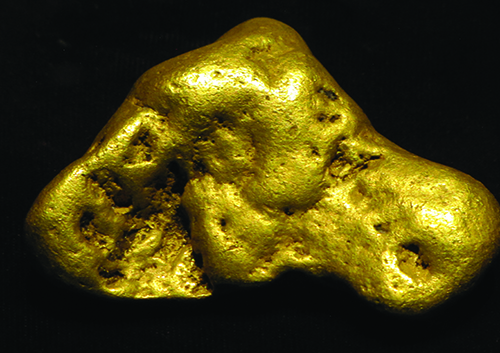
The 11.95-troy-ounce “Penn Hill nugget” is Colorado’s largest-known nugget. (Steve Voynick)
Gold mining even resumed along the South Platte River in Denver. To provide an income opportunity for the jobless, the city of Denver conducted free “gold-mining schools” in which experienced placer miners taught the largely forgotten arts of panning and sluicing. Thousands of out-of-work “students” participated, and the schools enabled their many “graduates” to pan or sluice a few dollars worth of gold every day—enough to put food on their tables. The renewed placer-mining activity also showed that the old-timers hadn’t found all the big nuggets. In 1937, high on Pennsylvania Mountain near Fairplay, miners recovered an 11.95-troy-ounce nugget. Named the “Penn Hill nugget,” it is the largest-known Colorado placer nugget ever found.
After World War II, inflation quickly caught up with $35 gold, and most of Colorado’s gold deposits were no longer worth mining. But the future of gold mining, not only in Colorado but worldwide, was already on the drawing boards in Cripple Creek. The Golden Cycle Corporation, the only surviving Cripple Creek mining company left from the boom days, constructed the Carlton Mill in 1950 to conventionally process the district’s few remaining ores. Like many districts, Cripple Creek had enormous quantities of gold mineralization left in the ground that was far too low in grade to mine profitably.
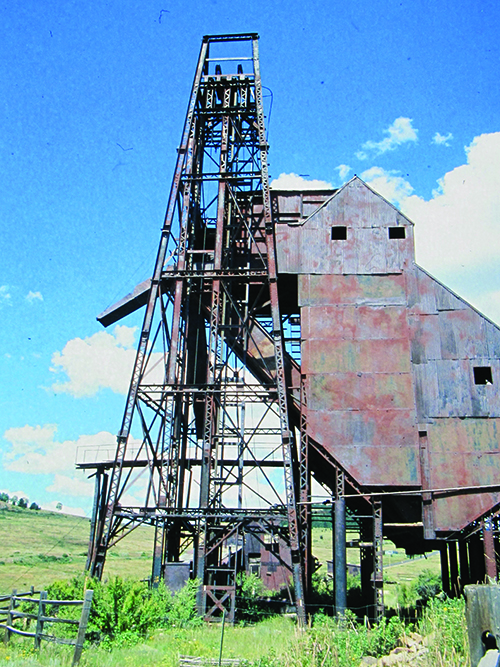
The 120-year-old, steel headframe of the Portland Mine, one of Cripple Creek’s richest mines, is now a historical attraction. (Steve Voynick)
When a United States Bureau of Mines research team needed a place to test an experimental cyanidation-recovery process, Golden Cycle generously donated an unused corner of its Carlton Mill. Cyanidation, which uses cyanide solutions to dissolve metallic gold from ores, was nothing new. It had been introduced in the 1890s, but its use was limited because the only way to recover the dissolved gold was through costly and inefficient precipitation with powdered zinc. In 1951, the Bureau of Mines researchers at the Carlton Mill developed an inexpensive process to recover the dissolved gold from cyanide solutions by adsorption onto particles of activated charcoal and chemically desorp the gold in metallic form. By making mass cyanide leaching of very low-grade gold ores profitable, this process would revolutionize gold mining.
Modern-Day Mining Market
By the 1970s, when gold had become a free-market commodity and its price had soared, the cyanidation-charcoal-adsorption approach was adopted worldwide. In Colorado, mining engineers planned its first use at Summitville. But before the low-grade ores were mined, the old district had one last surprise. In 1976, a contractor working with exploration geologists noticed a boulder “with a streak of yellow” lying just off the shoulder of the district’s main gravel road. The 141-pound boulder consisted of a breccia of quartz latite fragments in a matrix of fine-grained quartz, barite—and gold. Its largest, visible gold vein was 12 inches long and a half-inch thick.
Now known as the “Summitville gold boulder,” the rock contained 350 troy ounces of gold with a bullion value of $50,000 (the gold price was then $142 per toy ounce). The company that had leased the Summitville property took possession of the boulder but later donated it to the Denver Museum of Nature & Science. For his trouble and honesty, the contractor who discovered and reported the boulder received a $21,000 finder’s fee from the company. The modern Summitville open-pit gold mine operated from 1985 to 1992 and produced 250,000 troy ounces of gold—before coming to an inglorious end when cyanide leaks polluted downstream drainages and created a federal Superfund site.
In Colorado, the cyanidation-charcoal-adsorption process had its most significant impact on Cripple Creek itself. In the 1980s, Golden Cycle Corporation, a partner in the Cripple Creek & Victor Gold Mining Company, core-drilled the old mining district and delineated an enormous deposit grading only 0.027 troy ounces of gold per ton. The Cripple Creek & Victor Gold Mining Company open-pit mine began production in 1995 and has just recently poured its six-millionth troy ounce of gold. The recovered gold is melted in electric furnaces and poured into cone-shaped, 70-pound “buttons” of doré, an 85-15 gold-silver alloy that is 98 percent pure. Each button contains 720 troy ounces of gold and is currently worth $1.4 million. Nine million tons of ore are mined, hauled, crushed, and leached to pour more than 400 buttons each year.
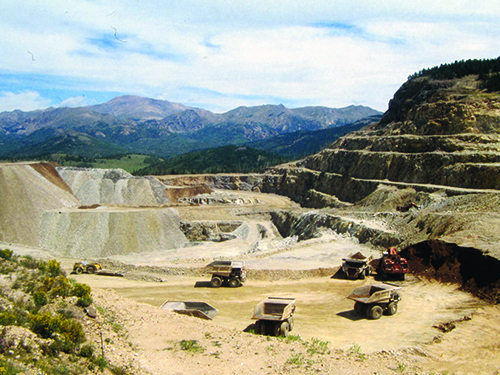
A section of the Cripple Creek & Victor Gold Mining Company’s modern open pit at Cripple Creek. (Steve Voynick)
Although Cripple Creek is now Colorado’s only primary gold source, the state’s golden legacy has not been forgotten. Colorado gold is showcased at the Denver Museum of Nature & Science, which displays many spectacular specimens of Farncomb Hill gold, along with Tom’s Baby, the Penn Hill nugget, and the Summitville gold boulder. In nearby Golden, the Colorado School of Mines library and Geology Museum also display fine specimens of Colorado gold.
Many of Colorado’s old gold-mining towns, including Idaho Springs, Central City, Black Hawk, Fairplay, and Cripple Creek, are within a two-hour drive of Denver. Most have local museums that display gold specimens and gold-mining artifacts, underground gold-mine tours, and other gold-related attractions. And gold panning and recreational dredging are popular summer activities on dozens of Colorado creeks and rivers.
Colorado’s gold-mining legacy now spans 160 years and is measured at ... "
Part 1: https://www.rockngem.com/the-saga-of-co ... Gold012821
Part 2: https://www.rockngem.com/the-saga-of-co ... art2012921